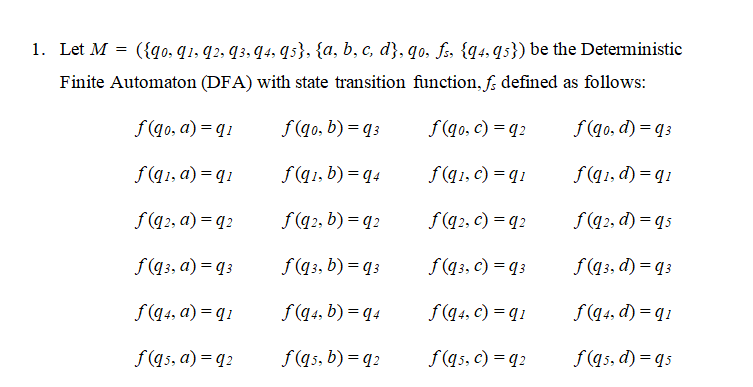1. Let M = ({qo, q1, q2, q3, q4, q5}, {a, b, c, d}, qo, fs, {q4, q5}) be the Deterministic Finite Automaton (DFA) with state transition function, f: defined as follows: f(qo, a) = q1 f(qo, b) = q3 f(qo, c) = q2 f(90, d) = q3 f(q1, a) = q1 f(q1, b) = q4 f(q1, c) = q1 f(q1, d) = q1 f(q2, a) = q2 f(q2, b) = q2 f(q2, c) = q2 f(q2, d) = qs f(q3, a) = q3 f(q3, b) = q3 f(q3, c) = q3 f(q3, d) = q3 f(q4, a) = q1 f(q4, b) = q4 f(q4, c) = q1 f(q4, d) = q1 f (qs, a) = q2 f(qs, b) = q2 f(qs, c) = q2 f(q5, d) = qs
1. Let M = ({qo, q1, q2, q3, q4, q5}, {a, b, c, d}, qo, fs, {q4, q5}) be the Deterministic Finite Automaton (DFA) with state transition function, f: defined as follows: f(qo, a) = q1 f(qo, b) = q3 f(qo, c) = q2 f(90, d) = q3 f(q1, a) = q1 f(q1, b) = q4 f(q1, c) = q1 f(q1, d) = q1 f(q2, a) = q2 f(q2, b) = q2 f(q2, c) = q2 f(q2, d) = qs f(q3, a) = q3 f(q3, b) = q3 f(q3, c) = q3 f(q3, d) = q3 f(q4, a) = q1 f(q4, b) = q4 f(q4, c) = q1 f(q4, d) = q1 f (qs, a) = q2 f(qs, b) = q2 f(qs, c) = q2 f(q5, d) = qs
Computer Networking: A Top-Down Approach (7th Edition)
7th Edition
ISBN:9780133594140
Author:James Kurose, Keith Ross
Publisher:James Kurose, Keith Ross
Chapter1: Computer Networks And The Internet
Section: Chapter Questions
Problem R1RQ: What is the difference between a host and an end system? List several different types of end...
Related questions
Question
DISCRETE STRUCTURE
- Construct a state transition diagram of a DFA that accepts all string over {U, T, M, 0, 1, 2} that contain string ‘22’ or ‘UTM’.

Transcribed Image Text:1. Let M = ({qo. q1, q2, q3, q4. qs}, {a, b, c, d}, qo. fs {q4. q5}) be the Deterministic
Finite Automaton (DFA) with state transition function, f; defined as follows:
f(qo, a) = q1
f (qo, b) = q 3
f(q0, c) = q2
f(q0, d) = q3
f(q1, a) = q 1
f(q1, b) = q4
f(q1, c) = q 1
f(q1, d) = q1
f(q2, a) = q2
f(q2, b) = q2
f(q2, c) = q2
f(q2, d) = qs
f(q3, a) = q3
f(q3, b) = q 3
f(q3, c) = q3
f(q3, d) = q3
f(q4, a) = q1
f(q4, b) = q4
f(q4, c) = q1
f(q4, d) = q1
f(q5, a) = q2
f(qs, b) = q2
f(q5, c) = q2
f(q5, d) = qs
Expert Solution
This question has been solved!
Explore an expertly crafted, step-by-step solution for a thorough understanding of key concepts.
This is a popular solution!
Trending now
This is a popular solution!
Step by step
Solved in 2 steps with 1 images

Recommended textbooks for you

Computer Networking: A Top-Down Approach (7th Edi…
Computer Engineering
ISBN:
9780133594140
Author:
James Kurose, Keith Ross
Publisher:
PEARSON

Computer Organization and Design MIPS Edition, Fi…
Computer Engineering
ISBN:
9780124077263
Author:
David A. Patterson, John L. Hennessy
Publisher:
Elsevier Science

Network+ Guide to Networks (MindTap Course List)
Computer Engineering
ISBN:
9781337569330
Author:
Jill West, Tamara Dean, Jean Andrews
Publisher:
Cengage Learning

Computer Networking: A Top-Down Approach (7th Edi…
Computer Engineering
ISBN:
9780133594140
Author:
James Kurose, Keith Ross
Publisher:
PEARSON

Computer Organization and Design MIPS Edition, Fi…
Computer Engineering
ISBN:
9780124077263
Author:
David A. Patterson, John L. Hennessy
Publisher:
Elsevier Science

Network+ Guide to Networks (MindTap Course List)
Computer Engineering
ISBN:
9781337569330
Author:
Jill West, Tamara Dean, Jean Andrews
Publisher:
Cengage Learning

Concepts of Database Management
Computer Engineering
ISBN:
9781337093422
Author:
Joy L. Starks, Philip J. Pratt, Mary Z. Last
Publisher:
Cengage Learning

Prelude to Programming
Computer Engineering
ISBN:
9780133750423
Author:
VENIT, Stewart
Publisher:
Pearson Education

Sc Business Data Communications and Networking, T…
Computer Engineering
ISBN:
9781119368830
Author:
FITZGERALD
Publisher:
WILEY